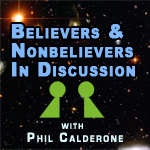 The Case for Christ, by Lee Strobel
One of the best Christian apologetic books, “The Case for Christ” makes a weak, diluted case, which says volumes about the field. It is written by an apologist via interviews with apologists. Strobel appears to take on a skeptical role but his acceptance–hook, line and sinker–of poor or speculative explanations for everything from the existence of Jesus to the question of divinity makes one wonder about the sincerity of his effort. If one grants that sincerity then Strobel is displaying a large dose of believence (credulousness).
Stroebel incessantly ignores or gives insufficient arguments against common explanations like myth-making or the possibility of Jesus as an everyday preacher. The argument is made that Jesus’ resurrection must have been true because without it the Christian faith would fall apart… Um, yeah. So he goes with a belief conclusion. This type of forced reverse logic is common with apologists.
One can give the benefit of the doubt for some questions like the existence of Jesus, but Strobel does not raise the burden of proof for supernatural events like Jesus walking around after death. Sorry no, for something like that you’re going to have to do better than ‘people said they saw him.’ Walking dead is no sleight of hand card trick.
For those who want to believe in Jesus and the whole package (biased by that condition) this book will probably do the trick. But those with unclouded reason will recognize the quick insufficiency of Strobel’s conclusions. This point is punctuated in the last paragraphs where he puts forth a horrible analogy, comparing seeing a physical person in real life with “…the witness of the Holy Spirit in our hearts.” No, these two things are not alike.
You are credulous, Mr Strobel. Case closed.
The Case for Christ, by Lee Strobel
One of the best Christian apologetic books, “The Case for Christ” makes a weak, diluted case, which says volumes about the field. It is written by an apologist via interviews with apologists. Strobel appears to take on a skeptical role but his acceptance–hook, line and sinker–of poor or speculative explanations for everything from the existence of Jesus to the question of divinity makes one wonder about the sincerity of his effort. If one grants that sincerity then Strobel is displaying a large dose of believence (credulousness).
Stroebel incessantly ignores or gives insufficient arguments against common explanations like myth-making or the possibility of Jesus as an everyday preacher. The argument is made that Jesus’ resurrection must have been true because without it the Christian faith would fall apart… Um, yeah. So he goes with a belief conclusion. This type of forced reverse logic is common with apologists.
One can give the benefit of the doubt for some questions like the existence of Jesus, but Strobel does not raise the burden of proof for supernatural events like Jesus walking around after death. Sorry no, for something like that you’re going to have to do better than ‘people said they saw him.’ Walking dead is no sleight of hand card trick.
For those who want to believe in Jesus and the whole package (biased by that condition) this book will probably do the trick. But those with unclouded reason will recognize the quick insufficiency of Strobel’s conclusions. This point is punctuated in the last paragraphs where he puts forth a horrible analogy, comparing seeing a physical person in real life with “…the witness of the Holy Spirit in our hearts.” No, these two things are not alike.
You are credulous, Mr Strobel. Case closed.
—–
The Case Against The Case For Christ, by Robert M Price Robert M. Price’s “The Case Against The Case for Christ” (Lee Strobel’s popular book) is both a critique of Strobel’s book and its specific arguments. On the overall book Price points out the major methodological flaw, being a collection of interviews with Christian apologists rather than a diverse set of scholars on various subjects from the historicity to the divinity of Jesus. Price knows who many of these scholars are, meaning they are not inaccessible. He cites them, others similar and his own analysis and yields alternate explanations of oddities in biblical content. He also compares the Bible to other writings of the era, noting similarities in style, content and purpose. Going further back he notes the same in much earlier writings. These draw a historical trend line as evidence of Christianity being yet another religion derived from previous supernatural beliefs, many rewriting similar elements (virgin birth, flood story, death and resurrection) while adding their own cultural spin. Of interesting note is his observation that ancient writers often prioritized purposeful messages over historical accuracy. Their point was lesson, not history. Too, “authors” were not always those who wrote the material but attributed to those whose name would give the content more legitimacy. Similarly, named authors could be compilations of writers unified into a fictional name (ex Moses). Moving forward to gospel times, Price points out the same pattern on a small scale–the Gospel of Mark being the earliest writing then the others being rewritten and elaborated on in a pattern consistent with mythopoeia. For more detail on this see Richard Carrier’s “On the Historicity of Jesus.” But Price is just one person so let’s put him under the same critical microscope I previously put Strobel (see my review of “The Case for Christ,” https://www.goodreads.com/review/show…). Price’s hypotheses of this or that circumstance are rational but generally lack sufficient evidence–particularly corroborating evidence–to make them the reliable most-likely true historical conclusions. Is this a criticism? No but it is a limitation. We are observing a researcher trying to put together pieces of a story puzzle to find a factual story beneath, if one exists. Contrast this to an apologist whose methodology is to twine together, often rationalize, puzzle pieces to a preferential storyline. Price shows himself to be more credible by following through on what he realized he must do to investigate naggingly inadequate apologetic arguments, ironically in a attempt to resolve those inadequacies:I knew it was a matter of basic honesty that I had to place myself, for the moment, in the shoes of the nonbeliever if I were to evaluate each argument for the historical Jesus or for Bible accuracy. I knew it would be phony for me to try to convince others by using arguments that I did not actually think were cogent. I didn’t want to use any tactics, say anything that might work, as if I were used car dealer or a mere propagandist.His journey led him to disbelief. Others with the same intention from the same starting point reach a different conclusion. The difference with “The Case Against The Case for Christ” is that there are no dissonance-inducing moments here, no extrapolations of under-justified preferences, no hypotheses miraculously elevated to Law. I cannot say the same for any apologetic book I have read. Not one. So in the end give both men their shot. Read Strobel’s book and read Price’s book, one after the other. See where you land.



